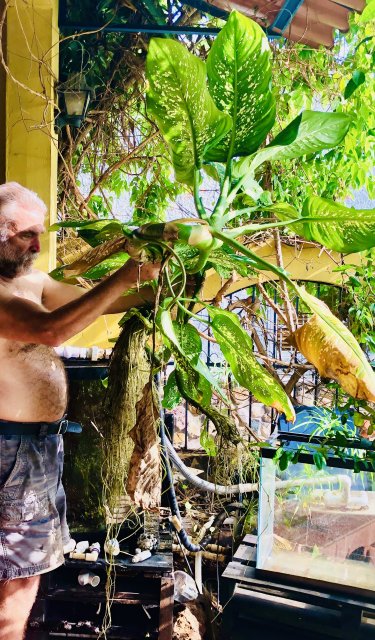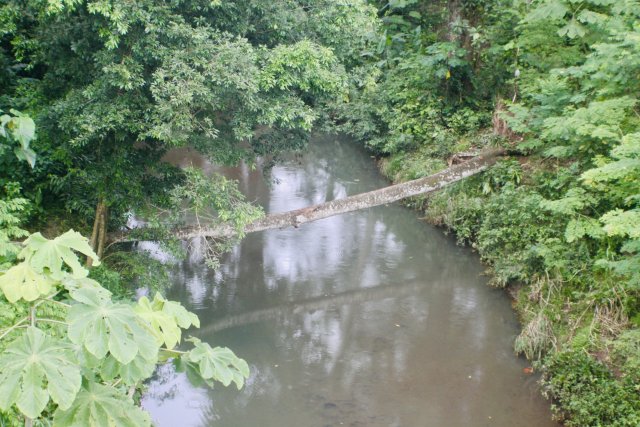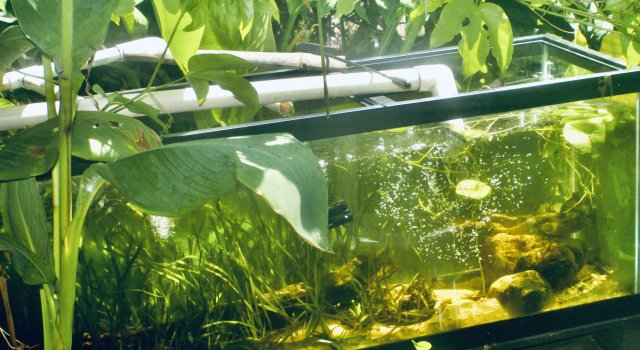Thanks yer I'm definitely open to having some tiger lotus, pothos and maybe an epiphyte or 2 but i plan for it to be a low light tank, probably just one 15w spotlight so I wouldn't imagine the plants would process a lot of nitrate. I'm hoping if I allow some tiger lotus to reach the surface where it has access to more light and unlimited co2 it will be fairly effective at consuming nitrates, this is the same reason I will be using pothos, having its leaves out of the tank where it has access to a load more co2 and natural ambient light it should do an even better job than the tiger lotus, I'm just not sure if they'll do enoughWell there are plants and then there are plants.
Your current tank looks like a bit of a fussy high maintenance type of planted tank. For a cichlid tank it doesnt need to look so pretty or well maintained.
I just redid my SA cichlid and used java fern stuffed into gaps in the rocks with some val planted in 1 corner and some elodea and lace fern floating around.
Its a very different effect than your previous tank and I think it still fits the look you are aiming for so might be worth considering?
View attachment 1476584
Central cichlids with nitrate
- Thread starter Tripping Willow 91
- Start date
You are using an out of date browser. It may not display this or other websites correctly.
You should upgrade or use an alternative browser.
You should upgrade or use an alternative browser.
I believe many aquarists have a somewhat exaggerated expectation of what a few Pothos plants, (or other terrestrial species) have the ability remove in the nitrate department. If a few large Pothos plants remove more than a 10th of a part per million I'd be surprised.
In my Panamanian biotope tank I have about 6 of these dieffenbachia (below) hanging on the surface, and still do 30%-40% every other day water changes to keep nitrate at my goal of <5ppm.

When you compare volume of plant life to animal life in nature, where in pristine waters nitrate is in the 1ppm or less range, plants overwhelm.

Above the rio Pedro Miguel in Panama. The water looks questionable, but when tested had undetectable nitrate concentrations, I assume the surrounding fauna sucked nitrate and other nutrients out as fast as it was produced.
For the OP, I like the idea suggested of using a smaller tank for a separate planted refugium (especially with Central American Cichlids) because of their tendency to destroy most rooted aquatic plants, not only by eating them, but also just clearing swaths of territorial space.
While a nitrate concentration of 20ppm does not kill cichlids outright, it often contributes to chronic diseases like hole in the head, or bloat over time, and a very heavily planted tank or sump could help mitigate the high nitrate tap water.
Without that type mitigation (even though I prefer to keep mainly cichlids), it might be a better idea to keep some of the large swamp dwelling Anabantids that tolerate nitrates well, like Combtails (Belontia), or climbing perch (Anabas) or giant Bettas. These fish are similar in appearance, size, and aggressiveness to cichlids, and fill a similar niche in high nitrate Asian waters.
Beside the heavy terrestrial planting in my 180 main tank, I use a heavily planted 125 gal as a sump/refugim as a nitrate sponge.

In my Panamanian biotope tank I have about 6 of these dieffenbachia (below) hanging on the surface, and still do 30%-40% every other day water changes to keep nitrate at my goal of <5ppm.

When you compare volume of plant life to animal life in nature, where in pristine waters nitrate is in the 1ppm or less range, plants overwhelm.

Above the rio Pedro Miguel in Panama. The water looks questionable, but when tested had undetectable nitrate concentrations, I assume the surrounding fauna sucked nitrate and other nutrients out as fast as it was produced.
For the OP, I like the idea suggested of using a smaller tank for a separate planted refugium (especially with Central American Cichlids) because of their tendency to destroy most rooted aquatic plants, not only by eating them, but also just clearing swaths of territorial space.
While a nitrate concentration of 20ppm does not kill cichlids outright, it often contributes to chronic diseases like hole in the head, or bloat over time, and a very heavily planted tank or sump could help mitigate the high nitrate tap water.
Without that type mitigation (even though I prefer to keep mainly cichlids), it might be a better idea to keep some of the large swamp dwelling Anabantids that tolerate nitrates well, like Combtails (Belontia), or climbing perch (Anabas) or giant Bettas. These fish are similar in appearance, size, and aggressiveness to cichlids, and fill a similar niche in high nitrate Asian waters.
Beside the heavy terrestrial planting in my 180 main tank, I use a heavily planted 125 gal as a sump/refugim as a nitrate sponge.

Last edited:
I've heard back from a few guys on a UK group and a couple of them are successfully keeping cichlids in tap water with the similar nitrates (one is 40ppm out the tap) to mine without issue. Others have suggested using a pozzani nitrate filter or nitrate resin either in my filter or in a nitrate resin vessel. Looking on the water company website the nitrate tests in my area are showing an average of 24ppm, I assume their testing equipment is far superior to my API test tubes so I'll take their average to be where mine is at. I've also found that the legal limit in the UK and most of Europe is 50 whereas in the US it's only 10. It's also not uncommon for the level to be 20+ straight out the tap in England, looking at the report for the area where I work the nitrate average is 32ppm, so I assume there are a lot of people keeping/farming/breeding cichlids in high tap nitrates throughout the UK and likely Europe, whether this is negatively affecting the fish remains to be seendo you have any idea what levels of nitrates others in your area typically have in cichlid tanks?
I think you're right in what you say, they are some crazy big plants to have hanging in your aquarium and looking at them I'd assume they were nitrate sponges but obviously not. From my own experience I've noticed I need a lot of plant mass to make a real difference. When I first started off I had a low tech tank with a fair amount of easy plants and they didn't really make any noticeable impact on my nitrates, then I added more, then a pothos, it wasn't until I was heavily planted, dosing lots of ferts and injecting co2 that I could really get my nitrates down to around 5-10ppmI believe many aquarists have a somewhat eggeagerated expectation of what a few Pothos plants, (or other terrestrial species) have the ability remove in the nitrate department. If a few large Pothos plants remove more than a 10th of a part per million I'd be surprised.
In my Panamanian biotope tank I have about 6 of these dieffenbachia (below) hanging on the surface, and still do 30%-40% every other day water changes to keep nitrate at my goal of <5ppm.
Yes that was a very good suggestion that I hadn't thought of and I'm sure would definitely be beneficial towards my nitrate situation but i just don't think it's a route I want to go down. Thank you for your other fish suggestions, had a quick Google and there are some interesting species amongst them but I'm really set on cichlidsFor the OP, I like the idea suggested of using a smaller tank for a separate planted refugium (especially with Central American Cichlids) because of their tendency to destry most rooted aquatic plants, not only by eating them, but also just clearing swaths of territorial space.
While a nitrate concentration of 20ppm does not kill cichlids outright, it often contributes to chronic diseases like hole in the head, or bloat over time, and a very heavily planted could help mitigate the high nitrate tap water.
Without that type mitigation (even though I prefer to keep mainly cichlids), it might be a better idea to keep some of the large swamp dwelling Anabantids that tolerate nitrates well, like Combtails (Belontia), or climbing perch (Anabas) or giant Bettas.
I could cut my tap water with RO 50/50 but would I need to add anything back to it, I'd rather not be messing with my water too much. What sort of max nitrate level should I be aiming for with my planned stock?
I missed this part of the question- If you do 50/50 you don't need to add anything as the 50% tap water should have enough buffering capacity itself. For most of these fish 20 nitrate should be the ceiling, highest point before WC, but many of us keep it lower than that.
I didn't realise earlier in the thread that you're from blighty! I'm just up the road in Lancashire! Looking at your area of Bedfordshire you are indeed cursed with abysmal water, one of the worse in the UK!
At this point I'll tag Stanzzzz7
. He's a top cichlid guy and he's a little closer to you around the Midlands area. He'll undoubtedly add value to this conversation. He only pops on once in a while though, but he'll reply when he gets my tag.
Stanzzzz7
. He's a top cichlid guy and he's a little closer to you around the Midlands area. He'll undoubtedly add value to this conversation. He only pops on once in a while though, but he'll reply when he gets my tag.
At this point I'll tag
Thanks everyone for all your suggestions I've now got lots of options to think about. For now I'll worry about buying the tank and getting it setup and cycled. Then I think I'll plant up some tiger lotus and pothos, load up my canister/s with plenty of bio media, put some lava rock piles in the aquarium and then once I've introduced my livestock I'll keep a close eye on things and if necessary I will try one of the more substantial methods. Thanks all appreciate all the input
Thanks for the tag.I didn't realise earlier in the thread that you're from blighty! I'm just up the road in Lancashire! Looking at your area of Bedfordshire you are indeed cursed with abysmal water, one of the worse in the UK!
At this point I'll tagStanzzzz7 . He's a top cichlid guy and he's a little closer to you around the Midlands area. He'll undoubtedly add value to this conversation. He only pops on once in a while though, but he'll reply when he gets my tag.
I'm going to be a little controversial here and say I would not worry about nitrate to much as long as it does not exceed 40ppm.
The fish you want to keep for the most part are tough cookies. Just keep conditions stable and stay away from wild caught fish and you will be fine. My preference is to not mix and match fish to much and give room for natural behaviour. A harem of sajica, 1 male and 3 /4 females with a group of swordtails would make for a nice c/a tank.
Due to your nitrate issue I would avoid tetras and stick with livebeares as all the other water chemistry results match their needs perfectly.
Best of luck.
Sadly I don't have any fishkeeping friends ? but I will definitely ask on a UK cichlid group I've joined , I know my LFS keeps all there fish in the standard tap water, apart from fussy soft water fish like discus etc then they cut it with RO
Well you do now.

Also, on a UK forum in the past I recall one of the moderators explaining that nitrate readings in UK tap water, are not taken using the same method as in the USA, and that 10 ppm US, is actually the same as approx 42 ppm UK. You might want to look into that as well.


